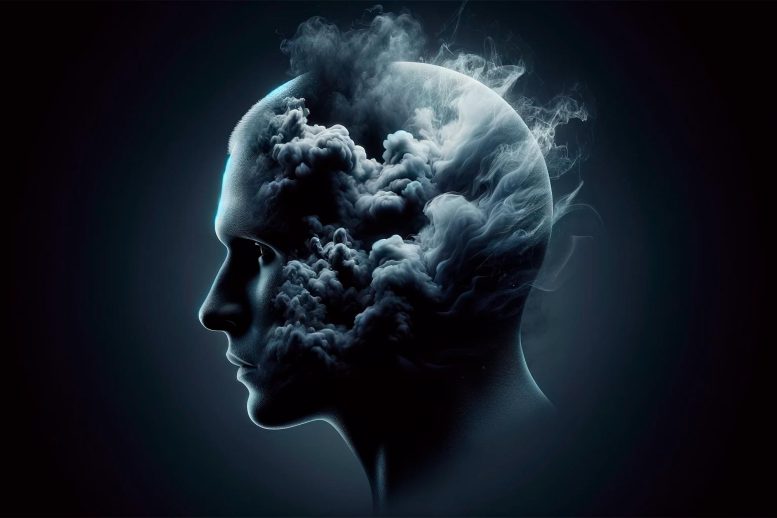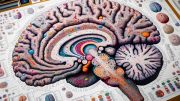
A new study by Yale scientists has identified a specific brain region that may cause paranoia by comparing behavioral data from monkeys and humans. This research utilized a novel approach, aligning animal and human studies using a computational model to analyze how participants perceive environmental stability and adapt to changes. The study, which also examined the effects of specific brain lesions in monkeys, provides insights into the neural underpinnings of paranoia and suggests a framework for future research on human cognition using simpler species. This could ultimately aid in developing better pharmaceutical treatments for paranoia. Credit: SciTechDaily.com
Yale researchers link brain regions to paranoia through a study of human and monkey behaviors.
The capacity to adjust beliefs about one’s actions and their consequences in a constantly changing environment is a defining characteristic of advanced cognition. Disruptions to this ability, however, can negatively affect cognition and behavior, leading to such states of mind as paranoia, or the belief that others intend to harm us.
In a new study, Yale scientists uncover how one specific region of the brain might causally provoke these feelings of paranoia.
Their novel approach — which involved aligning data collected from monkeys with human data — also offers a new cross-species framework through which scientists might better understand human cognition through the study of other species.
Their findings, and the approach they used, were recently published on June 13 in the journal Cell Reports.
While past studies have implicated some brain regions in paranoia, the understanding of paranoia’s neural underpinnings remains limited.
Study Methodology and Findings
For the new study, the Yale researchers analyzed existing data from previous studies, conducted by multiple labs, on both humans and monkeys.
In all of the previous studies, humans and monkeys performed the same task, which captures how volatile, or how unstable, a participant believes their environment to be. Participants in each study were given three options on a screen, which were associated with different probabilities of receiving a reward.
If the participants selected the option with the highest probability of reward, they would get a reward with fewer clicks across trials. The option with the lowest probability required more clicks to receive a reward. The third option, meanwhile, was somewhere in the middle. Participants did not have information on the reward probability and had to uncover their best option by trial and error.
After a set number of trials and without warning, the highest and lowest reward probability options flip.
“So participants have to figure out what’s the best target, and when there’s a perceived change in the environment, the participant then has to find the new best target,” said Steve Chang, associate professor of psychology and of neuroscience in Yale’s Faculty of Arts and Sciences and co-senior author of the study.
Linking Animal and Human Data
Participants’ clicking behavior before and after the flip could reveal information about how volatile they view their environment to be and how adaptive their behavior is within that changing environment.
“Not only did we use data in which monkeys and humans performed the same task, we also applied the same computational analysis to both datasets,” said Philip Corlett, an associate professor of psychiatry at Yale School of Medicine and co-senior author of the study. “The computational model is essentially a series of equations that we can use to try to explain the behavior, and here it serves as the common language between the human and monkey data and allows us to compare the two and see how the monkey data relates to the human data.”
In the previous studies, some of the monkeys had small but specific lesions in one of two brain regions of interest: the orbitofrontal cortex, which has been associated with reward-related decision-making, or the mediodorsal thalamus, which sends environmental information to the decision-making control centers of the brain. Among human participants, some had reported high paranoia and some did not.
The researchers found that the presence of lesions in both brain regions negatively affected the behavior of the monkeys, but in different ways.
Monkeys with lesions in the orbitofrontal cortex more often stuck with the same options even after not receiving a reward. Those with lesions in the mediodorsal thalamus, on the other hand, displayed erratic switching behavior, even after receiving reward. They appeared to perceive their environments as especially volatile, which was similar to what the researchers observed in the human participants with high paranoia.
Implications and Future Research
The findings offer new information about what is happening in the human brain — and the role the mediodorsal thalamus might play — when people experience paranoia, say the researchers. And they provide a pathway for how to study complex human behaviors in simpler animals.
“It allows us to ask how we can translate what we learn in simpler species — like rats, mice, maybe even invertebrates — to understand human cognition,” said Corlett, who, along with Chang, is a member of Yale’s Wu Tsai Institute, which aims to accelerate understanding of human cognition.
This approach will also allow researchers to assess how pharmaceutical treatments that affect states like paranoia actually work in the brain.
“And maybe down the road we can use it to find new ways to reduce paranoia in humans,” said Chang.
Reference: “Lesions to the mediodorsal thalamus, but not orbitofrontal cortex, enhance volatility beliefs linked to paranoia” by Praveen Suthaharan, Summer L. Thompson, Rosa A. Rossi-Goldthorpe, Peter H. Rudebeck, Mark E. Walton, Subhojit Chakraborty, Maryann P. Noonan, Vincent D. Costa, Elisabeth A. Murray, Christoph D. Mathys, Stephanie M. Groman, Anna S. Mitchell, Jane R. Taylor, Philip R. Corlett and Steve W.C. Chang, 13 June 2024, Cell Reports.
DOI: 10.1016/j.celrep.2024.114355
The work was led by co-first authors Praveen Suthaharan, a graduate student in Corlett’s lab, and Summer Thompson, an associate research scientist in Yale’s Department of Psychiatry. It was done in collaboration with Jane Taylor, the Charles B.G. Murphy Professor of Psychiatry at Yale School of Medicine.









Oh, no, they’re on to me!